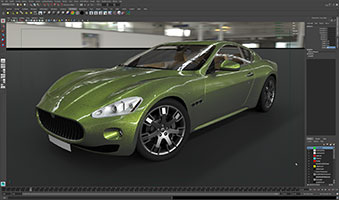|
Thanks for being a part of the NVIDIA Media and Entertainment community. We have enjoyed connecting with many of you in person over the past few months at events like SIGGRAPH, IBC, and Adobe MAX.
We're excited to announce that registration is now open for our biggest GPU technology conference ever, GTC 2015 on March 17-20 in San Jose, CA. GTC is the single-handed best place to meet GPU experts from leading companies across not only M&E, but also manufacturing, medical imaging, and more. Last year, we had over 3,400 attendees and inspiring keynotes by NVIDIA CEO Jensen Huang, as well as Pixar and UCSF.
Like previous years, we'll be organizing a Media and Entertainment track at GTC, offering sessions, talks, and workshops catered to your individual interests and aspirations.
This will be the best GTC yet, and I hope you'll register to be part of the excitement. As a thank you for being part of our community, you can use the discount code GM15ME for 20% off your registration. As always, we welcome any feedback or questions you have.
CONTENTS
|
 |
Greg Estes
GM, Media and Entertainment Industry
NVIDIA |
|
| |
| SPOTLIGHT |
GTC 2015 registration is now open!
March 17-20, 2015 in San Jose, CA
GPU Technology Conference (GTC) is the world's largest, most important GPU technology conference. You can connect with experts from NVIDIA and other organizations, discover what's next in GPU advancements, and gain insight in the 400+ sessions and hands-on labs. Top-tier organizations from a wide range of fields attend GTC, including Dreamworks, Electronic Arts, ESPN, Fox, NBC Universal, Netflix, Pixar, Sony, The Walt Disney Company, and more.
GTC 2015 will be the best one yet. Register now and use the discount code GM15ME for 20% off the lowest cost. Take advantage of early-bird pricing before January 20.
Missed GTC 2014? Click here to see the highlights. Also, if you're part of an early-stage startup doing cutting-edge work with GPUs, submit your entry to the Emerging Companies Summit to be one of 12 leading startups eligible to win a $100,000 grand prize. The deadline for submissions is January 19, 2015.
In the news
Top publications, including Digital Media World, Forbes, FXGuide, ICG Magazine, and Post Perspective, covered how the latest generation of NVIDIA® Quadro® GPUs powered the 6K production workflow of David Fincher's blockbuster hit Gone Girl. Read more about how NVIDIA, Adobe, and HP gave the movie the most advanced technical end-to-end workflow of any feature film to date. Check out the NVIDIA blog.
Also, check out NVIDIA's blog post on Renderosity describing how physically-based, GPU-accelerated ray tracing brings life to 3D workflows, written by NVIDIA's Sean Wagstaff. |
| |
| Media Applications and Technologies |
The Foundry certifies NUKE 9 with NVIDIA GPUs and HP workstations
The Foundry unveiled NUKE 9 on October 21, including the addition of NUKE STUDIO. For the first time, The Foundry has certified an HP and NVIDIA configuration with Blackmagic video i/o. Learn more.
Chaos Group releases V-Ray 3.0 for Maya
The new release includes optimized V-Ray RT GPU rendering. Certified on the NVIDIA® VCA, V-Ray RT for Maya's new features include render elements for final-frame rendering, full motion blur, V-Ray proxies, instancing, and new shader support, such as Maya noise. Learn more.
OTOY releases CUDA-powered OctaneRender 2.1 with new features
OTOY announced the availability of the latest version of its NVIDIA® CUDA®-powered, real-time rendering software. The software features render pass output for lighting layers, an Undo system, improved sampling, and a scriptable node graph SDK for developers. Learn more.
Quantel Pablo Rio goes 8K 60p powered by NVIDIA Tesla
Quantel has optimized its Pablo Rio software and is harnessing the power of multiple NVIDIA® Tesla® GPUs to deliver realtime 8K 60p post production. Check out the world debut in the Quantel and Snell booth at InterBEE in Tokyo on November 19-21.
NVIDIA® Tesla® GPU powers Wohler's new media re-timing solution
The new Tachyon Wormhole solution from Wohler Technologies allows users to re-time video, audio, and caption data perfectly, with no perceptible loss of quality and at speeds that are unmatched. Learn more.
Wavelet Beam's new GPU-based transcoding product
Wavelet Beam's VIDEO CLEANUP & TRANSCODE integrates cleanup and de-noising functionalities for ultra-low bandwidth encoding. Plus, it supports common container formats and the newest encoders like H265/HEVC. VIDEO CLEANUP & TRANSCODE also migrates VOD archives and provides huge cost savings for CDN and backbone distribution. Read more.
EditShare's Lightworks approves latest NVIDIA GPUs
The NVIDIA® Quadro® K5200, K4200, and K2200 are now officially approved to work with the latest version of Lightworks on Windows and Linux systems. Read more.
v3 GPU-accelerated QuickS3D plug-in for Adobe Premiere® Pro
QS3DX provides full-frame, full-speed 4K SBS stereoscopic viewing and significantly faster rendering performance when using an NVIDIA GPU. Learn more and install. |
| |
| Customer successes |
Warner Bros, DC Entertainment, and OTOY create first commercial holographic video
OTOY has announced work on a groundbreaking immersive entertainment experience developed in OctaneRender using NVIDIA GPUs. It's a fascinating look at how the Emmy® Award–winning Batman: The Animated Series was brought to life using interactive holographic video for virtual reality. Learn more.
Snell's Alchemist OD delivers One Direction concert for Cinema screening
One Direction producer has chosen NVIDIA GPU-powered Alchemist OD to deliver superb viewing experience on the big screen when converting One Direction's Where We Are concert film from 1080 29.97p to 1080 24p. Read more.
Aston 3D uses NVIDIA Quadro to enhance Setanta's RT Graphics
Brainstorm's Aston 3D helps Setanta Sports, Ireland's foremost sports broadcaster, used NVIDIA Quadro K6000 extensively to create and deliver sophisticated, demanding, real-time animated 3D graphics. Read more.
NVIDIA-powered Tachyon Wormhole wins HPA 2014 Engineering Excellence Award
Cinnafilm and Wohler took home the HPA 2014 Award for Tachyon Wormhole, designed to be a turnkey solution for operations desiring to shorten or lengthen video projects by 10% - all powered by NVIDIA GPUs. Read more. |
| |
| Events |
Autodesk showcases the latest Flame Premium and Maya updates in Scandinavia
On November 12-14, Autodesk, NVIDIA, and PNY will host live presentations and talks covering the latest updates on Maya, Flame Premium, NVIDIA® Quadro®, and NVIDIA® VCA.
Register for Stockholm – November 12th from 13:00-17:00 CET
Register for Gothenburg - November 13th from 13:00-17:00 CET
Register for Copenhagen - November 14th from 13:00-17:00 CET
GPU-rendering webinar: Easy photorealism with Iray for Maya
Did you miss the GTC Express Webinar on "Easy to Use Photorealistic Rendering with Iray for Maya"? Watch the recording and access PDF slides. For more, learn about 0x1 IrayForMaya and NVIDIA Iray product features. |
| |
| TIPS AND TRICKS |
Three easy steps to use GPU rendering with V-Ray RT and Maya
The newly-shipping Chaos Group's 3D renderer, V-Ray 3.0 for Maya, now features an improved implementation of V-Ray RT, its GPU-accelerated ray tracing mode, with many new features and enhancements for final-frame rendering.
V-Ray RT supports most V-Ray shaders and lights, as well as most standard Maya materials, many of which worked previously only with the CPU version of V-Ray. Rendering with V-Ray RT is particularly fast when using the V-Ray Light Dome with an HDR image as the light source, and it offers interactive, progressive rendering in the viewport.
Here's how to use GPU rendering with V-Ray RT and Maya:
- In Maya, with V-Ray 3.0 selected as your renderer, open the Render Settings dialog (Window > Rendering Editors > Render Settings) and use the following settings:
- Render Using: V-Ray
- RT Engine > Engine > Type: CUDA (single kernel)
- RT Engine > Performance > Progressive RPP (rays per pixel): Enable
- RT Engine > Performance > GPU Ray bundle size: Low for interactive high for quality*
- RT Engine > Performance > GPU Rays per pixel: Low for interactive high for quality*
*Set values for GPU Ray bundle size and GPU Rays per pixel low to emphasize interactive performance. Increasing the ray and bundle sizes makes it less responsive, but the final-quality image renders faster.
- In the menu at the top of the perspective viewport, choose Renderer > V-Ray RT.
- After a few seconds, your image should start to render in the viewport, becoming beautifully resolved quickly and seamlessly.

If your system only has one GPU, V-Ray RT will take it over completely while rendering, and on-screen navigation may become sluggish. If GPU rendering is something you want to pursue, consider adding GPUs to your system to provide better OpenGL performance. V-Ray RT 3.0 will scale across multiple GPUs, including multiple NVIDIA® VCA rendering appliances.
For more information, go to www.v-ray.com/maya or visit Chaos Group at www.chaosgroup.com. |
| |
Find us online:
|
| |
 Copyright © 2014 NVIDIA, the NVIDIA logo, GeForce, the GeForce logo, Maximus, PhysX, Quadro, SLI, Tesla, Tegra, and 3D Vision are registered trademarks and/or trademarks of NVIDIA Corporation in the United States and other countries. All other company and product names are trademarks or registered trademarks of the respective owners with which they are associated. Copyright © 2014 NVIDIA, the NVIDIA logo, GeForce, the GeForce logo, Maximus, PhysX, Quadro, SLI, Tesla, Tegra, and 3D Vision are registered trademarks and/or trademarks of NVIDIA Corporation in the United States and other countries. All other company and product names are trademarks or registered trademarks of the respective owners with which they are associated.
All rights reserved. 2701 San Tomas Expressway, Santa Clara, CA 95050.
|
|
|
